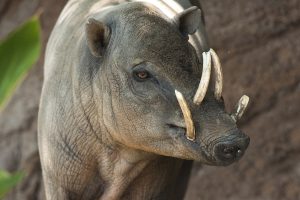|
Getting your Trinity Audio player ready...
|
On Friday, December 15th, Zoo Miami welcomed the birth of an endangered babirusa, the first successful birth of this species in the history of the zoo! This is the first baby for both parents, a nearly 5-year-old female named Maggie, from the St. Louis Zoo, and a nearly 5-year-old male named, Harry, from the Audubon Zoo. The sex of the newborn is still undetermined as it remains isolated with its mother in a secluded holding area.

Of the over 20 different species of wild swine in the world, the unique babirusa is considered to be one of the most bizarre looking. The word “babirusa,” means “pig deer” in the Malay language. This is believed to come from the strange appearance of males whose tusks look like antlers growing on the top of its head. Unlike other pigs, the babirusa has a set of upper tusks that grow up through the top of its face and sometimes curl all the back into its head! These upper tusks, combined with a second set on the lower jaw that curl up and out away from the head, create an almost alien appearance that causes many to consider the babirusa the strangest looking pig in the world. Females do not exhibit these tusks and both sexes are relatively hairless.


Babirusas are found in the swamps and rainforests of Indonesia. In the wild, they have a lifespan of approximately 10 years but can live up to 20 years under human care. They are omnivorous and feed primarily on fruits, roots, invertebrates, and small mammals, but will eat almost anything including on occasion, their own young. Males will battle with each other for territory by standing on their hind legs and punching with their front ones. Their greatest threats are habitat loss and hunting for food.
Though Harry, the father, can be seen on public display daily, both the mom and baby, will likely remain off exhibit for the next several weeks to ensure that the baby can properly navigate the challenges of a moated habitat.





